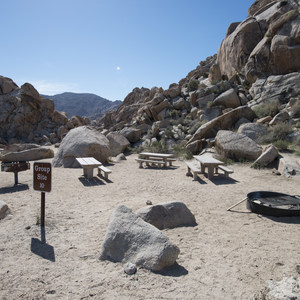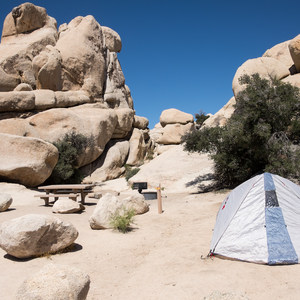Indian Cove to Willow Hole is a scenic, moderately challenging backpacking route in Joshua Tree National Park. This journey begins at the Indian Cove Trailhead and follows the Boy Scout Trail through iconic rock formations, expansive washes, and rugged wilderness, ultimately leading to the picturesque Willow Hole, an oasis in the desert. The total distance is approximately 18.1 miles out-and-back, making it ideal for an overnight or long day hike for those looking to explore Joshua Tree's quieter backcountry. This backpacking trip offers a wonderful opportunity to experience the serene beauty and solitude of Joshua Tree’s desert landscapes.
DESCRIPTION
Start your hike at the Indian Cove trailhead, located near the Indian Cove Campground off Indian Cove Road. From here, follow the Boy Scout Trail through the rocky, boulder-filled terrain that defines much of Joshua Tree National Park. The trail gradually ascends and weaves through desert washes lined with Joshua trees, cholla cacti, and unique rock formations.
A few miles in, you’ll reach the junction for the trail to Willow Hole. This section of the trail becomes more rugged and narrows as you approach the hidden oasis. The trail meanders through sandy washes surrounded by towering boulders, eventually leading to Willow Hole, where desert willows and lush greenery contrast with the arid landscape. This secluded spot often holds water in the cooler months, providing a perfect place to take a break and soak in the beauty of the desert.
FLORA AND FAUNA
The trail passes through diverse desert ecosystems, featuring Joshua trees, ocotillo, and the desert willows at Willow Hole. In spring, wildflowers like lupines and desert marigolds bloom along the route. Keep an eye out for wildlife, including desert tortoises, lizards, and jackrabbits. Occasionally, you may spot bighorn sheep in the more remote areas.
WATER SOURCES
Water sources in Joshua Tree National Park are scarce and vital for wildlife. Therefore, hikers and backpackers should carry plenty of water and ensure they have enough for both hiking and camping, especially on overnight trips.
CAMPING AND PERMITS
Backcountry camping is allowed in Joshua Tree National Park, but you must be at least 1 mile from the road and 500 feet from the trail. Permits are required for overnight backcountry camping and can be obtained from www.recreation.gov.
SAFETY AND CONSIDERATIONS
-
Weather: The desert can be extremely hot during the day and cold at night, especially in the winter months. Be prepared with layers and sun protection.
-
Navigation: While the trail is well-marked, the terrain can be rugged. A map or GPS is recommended, especially around the Willow Hole area where washes and rock formations may make navigation tricky.
-
Sun Exposure: Shade is minimal, so pack a hat, sunscreen, and sunglasses.
-
Wildlife: Keep a respectful distance from wildlife and be mindful of rattlesnakes, especially during warmer months.
PARKING
Parking is available at the Indian Cove Campground or the trailhead near the Boy Scout Trail. Be sure to arrive early during peak seasons to secure a spot.






















Comments
Sign In and share them.